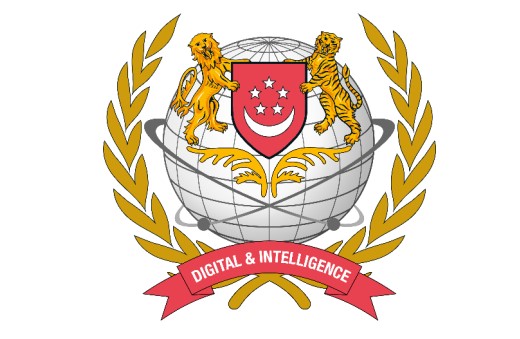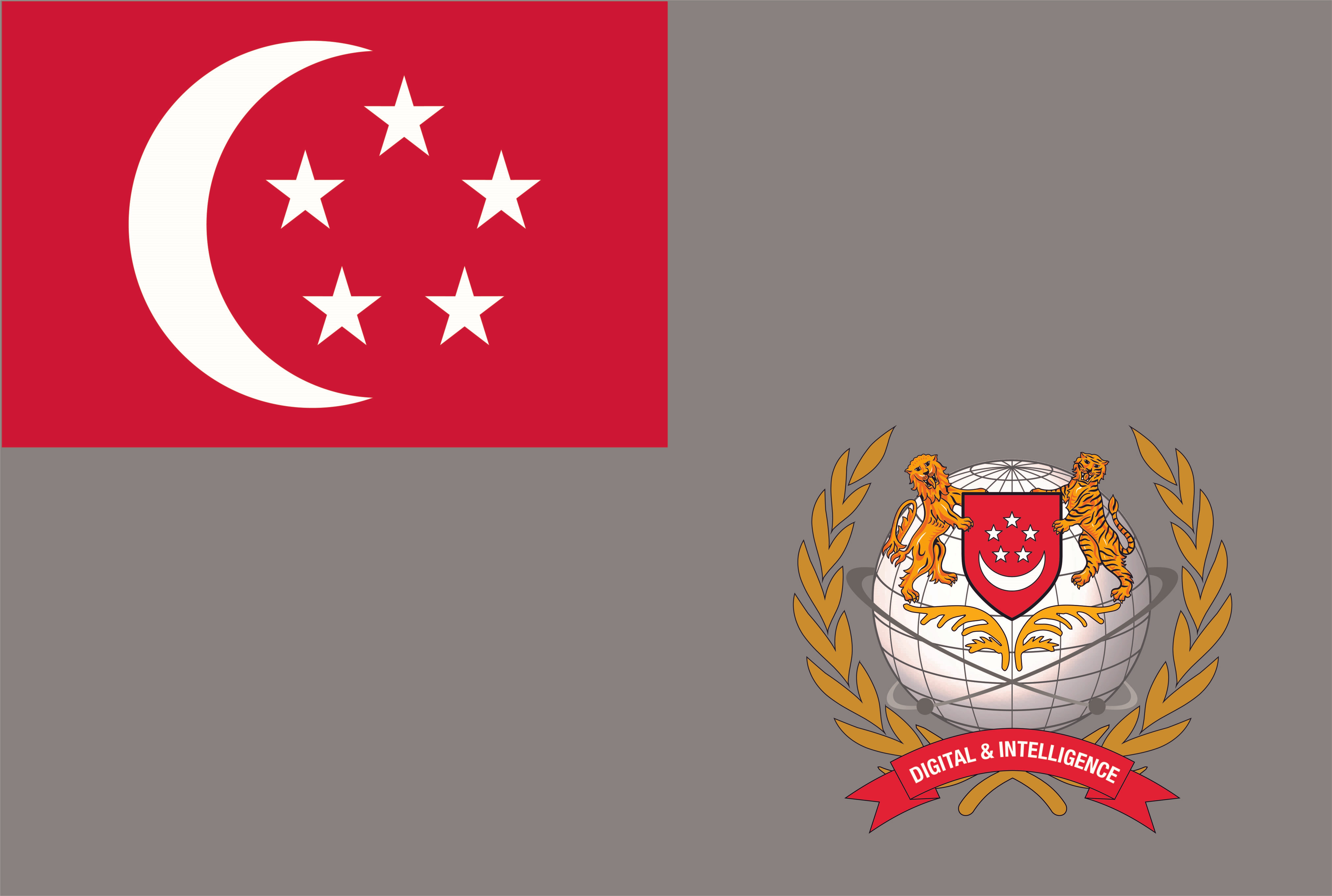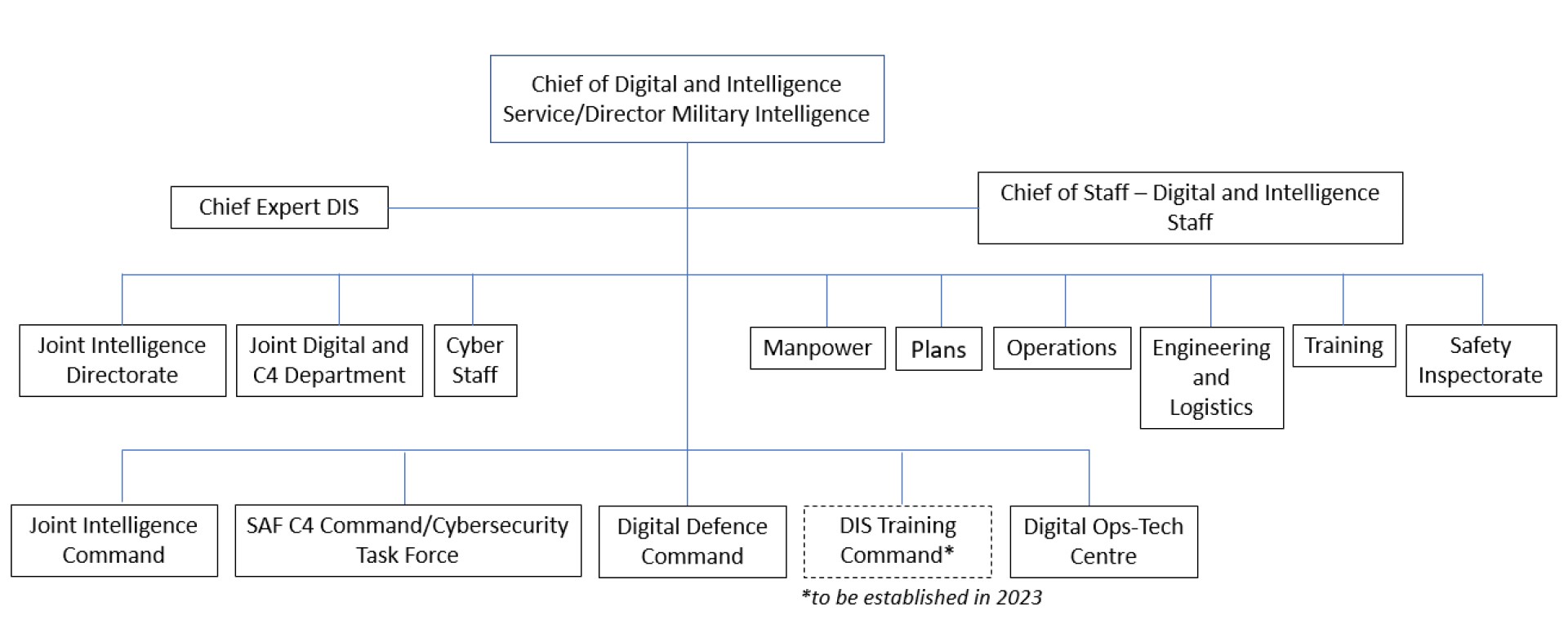Fact Sheet: The Digital and Intelligence Service
28 October 2022
This article has been migrated from an earlier version of the site and may display formatting inconsistencies.
Introduction
The establishment of the fourth Service of the Singapore Armed Forces (SAF) – the Digital and Intelligence Service (DIS) – marks a key milestone in the transformation of the Next Generation SAF. The DIS sees the consolidation and integration of existing Command, Control, Communications, Computers and Intelligence (C4I) as well as cyber capabilities of the SAF. As a dedicated Service, the DIS will raise, train and sustain digital forces and capabilities to fulfil their mission to defend the peace and security of Singapore from evolving and increasingly complex threats in the digital domain.
a. Mission. The DIS will defend and dominate in the digital domain. As part of an integrated SAF, the DIS will enhance Singapore's security, from peace to war. The DIS plays a critical role in defending Singapore from threats in the digital domain, and allows the SAF to operate better as a networked and integrated force to deal with a wider spectrum of external threats to enhance and safeguard Singapore's peace and sovereignty.
b. DIS Crest. The design of the DIS Crest represents its support for the full spectrum of operations and its contributions towards the peace and security of Singapore. The networked globe, enveloped by criss-crossing rings, signifies the DIS' operating domain and its shared identify as a Service. The rings symbolises the DIS' ability to be agile and integrate across various operations, while the two electrons linking the globe and rings represents the digital domain which the DIS operates in. The golden laurels, a common feature of all SAF Services' crests, symbolise the DIS' commitment to achieving mission success, and the red banner represents the unity and loyalty of DIS personnel.

c. DIS Flag. The grey background in the Service Flag of the DIS symbolises the steadfast resolve of DIS in supporting the SAF's full spectrum of operations, while the DIS Crest symbolises the critical role the DIS plays in safeguarding and securing Singapore's peace and sovereignty.

Organisational Structure of the DIS
The DIS is led by the Chief of Digital and Intelligence Service (CDI), and supported by the Chief of Staff - Digital and Intelligence Staff (COS-DS) and Chief Expert DIS (CXDI) [1]. The DIS comprises a Service Headquarters (HQ), selected Joint and Cyber Staff departments, four Commands and a Digital Ops-Tech Centre (DOTC).

Joint and Cyber Staff Departments [2]
a. Joint Intelligence Directorate (JID). The JID supports MINDEF/SAF's decision-making and operations through research and analysis, doctrines, standards and best practices as well as the integration of intelligence and operations. The JID works closely with the Services' Intelligence entities and the Joint Intelligence Command (JIC) under the ambit of the Military Intelligence Organisation (MIO) [3].
b. Joint Digital and C4 Department (JDCD). The JDCD steers the digitalisation of the SAF by developing the digital strategy, master plan and resource governance, defining and measuring digital growth and raising digital literacy to create a digital-ready workforce. It also partners the Defence Technology Community (DTC) to drive and develop the technical standards and governance for SAF digital products to ensure agility, interoperability, scalability, security and sustainability.
c. Cyber Staff. The Cyber Staff leads and coordinates cybersecurity across the defence sector. The Cyber Staff develops cyber defence strategies and policies, orchestrates capability development for cyber defence and supports the Cyber Security Agency (CSA) Singapore when required.
DIS Commands and Ops-Tech Centre
d. Joint Intelligence Command (JIC). The JIC supports the Ministry of Defence (MINDEF) and the SAF's intelligence requirements. The JIC provides accurate, relevant and timely intelligence to aid in early warning and decision-making of the SAF's operations when required. The JIC, which comprises a HQ and two Brigade-equivalent groups, Imagery Support Group (ISG) and Counter-Terrorism Intelligence Group (CTIG), is tasked to raise, train and sustain intelligence personnel for the DIS.
e. SAF C4 Command/Cybersecurity Task Force (SAFC4COM/CSTF). The SAFC4COM/CSTF operates and safeguards the Command, Control, Communications and Computers (C4) capabilities for MINDEF/SAF. The SAFC4COM/CSTF, which consists of two-Brigade equivalent groups, the C4 Operations Group (C4OG) and Cyber Defence Group (CDG), works together as a networked and integrated force to support the full spectrum of SAF's operations. They are also tasked to raise, train and sustain C4 and cyber personnel for the SAF.
f. Digital Defence Command (DDC). The DDC develops electronic protection [4] and psychological defence capabilities for MINDEF/SAF to address evolving threats and security challenges. The DDC explores and introduces suitable electronic protection and psychological resilience measures for the SAF, as well as assists to incorporate the necessary measures within the daily functions of the other SAF Services. The DDC consists of sub-units, the Electronic Protection Group (EPG) and Psychological Defence Group (PDG), which focus on capability development within their respective domains.
g. DIS Training Command (DTCOM). The DTCOM will be responsible for development of the DIS workforce, with training schools for vocational and advanced competencies training in intelligence and cyber, as well as staff functions for various curriculum development and training support. The DTCOM is expected to be established in 2023.
h. Digital Ops-Tech Centre (DOTC). The DOTC enables the SAF to develop agile responses to meet changing operational requirements on the digital frontier, while developing a digital core well-versed in data science and Artificial Intelligence (AI) technologies to sharpen the SAF's operational edge. As the SAF's centre of excellence for digital expertise, the DOTC partners the Defence Technology Community (DTC), Whole-of-Government digital agencies, academic institutions and industry experts to stay updated on best practices in its approaches and culture. Beyond developing the SAF's digital experts through the C4 Experts and Digital Specialist schemes, the DOTC also promotes mentorship and cultivates an environment for innovation and collaboration on projects by the SAF's operational units.
DIS Workforce
A highly-skilled digital workforce is key to the digital defence strategy of the SAF. The DIS is keen to attract and develop both military and non-uniformed digital experts to grow the SAF's digital workforce. There are currently three vocations under the Military Domain Expert Scheme (MDES), as well as other vocations under the Defence Executive Officer (DXO) scheme:
MDES Vocations
a. C4 Expert (C4X). The C4Xs anchor MINDEF/SAF's cyber defence and address emerging threats, by developing digital products and solutions to provide the SAF with a technological edge in the digital domain. These experts are well-versed in digital competencies, such as software engineering, app development, data science and AI, as well as cloud architecting. The C4Xs are also responsible for areas of security monitoring, cyber incident response, vulnerability assessment and penetration testing, malware analysis and cyber forensics, as well as cyber threat intelligence operations.
b. Military Intelligence Expert (MIE). The MIEs provide accurate, relevant and timely intelligence to support national security and policymaking. With backgrounds in technical and humanities disciplines such as regional security, psychology and humanities, the MIEs have specialised analytical skills and deep operational knowledge to discover new sources of information and distil intelligence. They also leverage technologies to uncover new threats, while identifying gaps and vulnerabilities significant to Singapore. These experts collect accurate and actionable intelligence through different domains amidst the complexities of intelligence operations to shape the outcome of the military campaign.
c. Digital and Intelligence Systems Engineer (DISE). The DISEs are responsible for the day-to-day operations of the SAF's strategic communications, information and sensor systems. At the forefront of emerging technologies, the DISEs work with operational users, defence and industry partners to apply their technical expertise towards implementing plans and integrating new solutions into the SAF's existing technology ecosystem. These experts ensure that the SAF's systems are progressively updated, from design and development to validation and operation, with advanced technologies and concepts to ensure that the DIS and SAF systems are operationally ready to face the ever-evolving security environment.
DXO Vocations
d. Defence Cyber Experts (DCX). The DCXs – a specialisation under the DXO scheme and the counterparts of the C4Xs – are deployed to defend MINDEF/SAF systems and networks by providing expertise in cyber threat intelligence, forensics, penetration testing, development of software, data science and digital infrastructure.
e. Defence Executive Officer (DXO – Research, Mapping and Connectivity). The DIS leverages the diverse capabilities of DXOs with expertise and specialised skillsets to work together with their military counterparts. The DXOs are well-versed in areas such as policy formulation, research, geospatial and mapping, maintenance and operation of networks.
The DIS will also leverage National Servicemen to develop its digital workforce. Operationally Ready National Servicemen (NSmen) with matching talents and relevant civilian expertise can express interest to serve in the DIS through the Enhanced Expertise Deployment Scheme [5]. Full-time National Servicemen (NSFs) with suitable skills are offered to participate in DIS-related Work-Learn Schemes (WLS) where they will be able to undergo military training and serve NS while attaining academic credits which will contribute to the eventual completion of a relevant university degree. There are currently two DIS-related WLS:
a. Digital Work-Learn Scheme (Digital WLS[6]). Introduced in March 2022, pre-enlistees who enlist from April 2023 and are interested in Computer Science, Computer Engineering or data science and AI are welcome to apply for the Digital WLS. Over the course of the four-year scheme, the NSFs under the WLS – Digital Specialists (DigiSpecs) – will have opportunities to hone their skillsets through vocational and academic training in areas of data science, software development and AI. The DigiSpecs will serve in roles including data engineering, AI model experimentation and development, operational deployment of technologies, and User Experience (UX) and User Interface (UI) design to help meet the SAF's increasing digitalisation needs.
b. Cyber Work-Learn Scheme (Cyber WLS [7]). Introduced in February 2018, all pre-enlistees interested in cybersecurity are welcome to apply for the Cyber WLS. Over the course of a three or four-year scheme, Cyber Specialists (CySpecs) will have opportunities to hone their skillsets through vocational and academic training to deal with advanced cyber threats, engage in real-world cybersecurity operations and contribute to the nation's cyber ecosystem. The CySpecs serve in roles ranging from threat monitoring and assessment, to cyber forensics, incident response, malware analysis and penetration testing to address wide-ranging cyber threats.
[1] The CXDI will plan and oversee the expertise development of DIS personnel, and play key leadership roles in the conduct of operations, as well as ensure regimentation and operational discipline in the context of the DIS mission and operating environment. It is the equivalent to the appointment of Sergeant Major of the Army, Air Force Command Chief and Master Chief Navy.
[2] Dual-reports to the Chief of Defence Force (CDF) and the CDI.
[3] The MIO provides dedicated intelligence support for counter-terrorism early warning and incident response, through system and capabilities that can uncover, investigate and monitor threat concerns. The MIO also works closely with other national agencies as part of national counter-terrorism efforts.
[4] Electronic protection involves safeguarding personnel, facilities, and equipment against the effects of an electronic attack by hostile forces that could neutralise or destroy its combat capabilities.
[5] The scheme, formerly known as the Expertise Conversion Scheme, allows MINDEF/SAF to better optimise and maximise expertise that NSmen have picked up in their civilian lives, and allow the SAF to better meet its operational needs. There are niche domains within MINDEF/SAF where NSmen may be redeployed to, such as cyber, law, medicine, engineering, psychology and info-communications.
[6] NSFs under the Digital WLS will serve for four years, developing AI applications and performing software engineering tasks in support of real-world military operations while taking up modules to earn academic credits at Nanyang Technological University that contribute to a degree in Data Science and AI, Computer Science or Computer Engineering. By the end of the four-year period, they will earn 50 per cent of academic credits and can complete their studies in another two years.
[7] NSFs under the Cyber WLS can serve either 3 or 4 years with MINDEF/SAF as Cyber Specialists in specialised cyber roles, during which they will receive vocational and on-the-job training in the SAF, and earn academic credits by taking modules of relevant university programmes from the Singapore Institute of Technology and National University of Singapore.
More Resources
